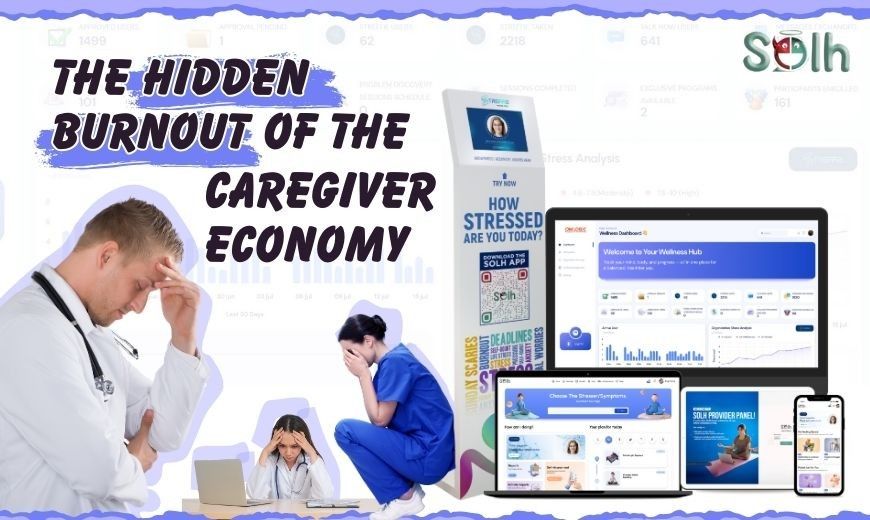All companies monitor expenditure: wages, activities, advertising, information technology, and leases.
However, one line item that is huge, unseen, and not budgeted is employee stress.
Several studies and our internal models at Solh have indicated that the cost of workplace stress in India is silently burning Corporate India a hole of almost 1.1 lakh crores per annum. Yes, you heard it correctly; 110 crores, 1100 million, 110 billion, and it is leaking out of both big and small businesses.
This is not some kind of abstract, soft HR problem. It is a tough business challenge.
On the one hand, today, we are going to unravel what is contributing to this loss, why leaders tend to underestimate it, and how organizations can finally get control of this increasing expense.
How Stress Quietly Destroys Corporate Balance Sheets
1. The Productivity Black Hole
Let us start with what is obvious. The stressed employees are distracted, tired, and uninterested. Studies suggest:
- Chronically stressed teams experience a 20-30 percent decrease in productivity.
- Cognitive fatigue results in greater error, decreased performance speed, and inability to make decisions.
- Presenteeism (turning up and not being present) is a major drain on output.
A 10 percent decline in productivity in a 5,000-employee organization clearly illustrates the cost of workplace stress in India, it directly affects bottom lines.
2. Absenteeism and Medical Leaves
Chronic stress not only remains in the mind, but it also strikes the body.
Sleep disorders
- Migraines
- Gastro issues
- Hypertension
- Anxiety-induced illnesses
In India, almost 17 percent of sick leaves are related to mental health or stress-related problems.
Each work day lost is a loss- it affects deadlines, the morale of the team, and the total costs of the project.
3. Hospital 176 Attrition & Talent Drain
This is perhaps the most expensive expense: loss of good people.
When stress levels are too high, employees take a walk:
- Greater loss of people = more hiring and training expenses.
- The institutional knowledge is lost.
- Interruption of customer relations.
- Bad-image employer branding.
According to the LinkedIn 2023 India Workforce Report, mental wellbeing has become of the top 3 factors that mid-level professionals change jobs.
4. Errors, Safety, and Compliance Violations
Stress decreases concentration. And that is not only bad when it comes to coding or marketing, in high-stakes industries, such as healthcare, manufacturing, banking, or IT security, the cost of workplace stress can lead to:
- Compliance violations
- Data breaches
- Injuries and accidents
- Regulatory penalties
Such debts are able to kill businesses within a single night.
5. Legal and insurance expenses
As the discussion on mental health grows, organisations that do not offer psychological safety are soon to face:
- Lawsuits concerning harassment in the workplace, unhealthy culture, or laxity.
- Rising stress-related claims were followed by increased insurance premiums on health coverage.
What Is The True Cost Of Work-Related Stress?
Stress Impact | Annual Loss (Estimates) |
Productivity Loss | ₹45,000 crore |
Absenteeism | ₹15,000 crore |
Attrition Costs | ₹20,000 crore |
Healthcare & Insurance | ₹18,000 crore |
Errors & Compliance | ₹12,000 crore |
Total Estimated Annual Cost = ₹1.1 lakh crore
And mind you — this does not even include the long-term brand damage, client losses, or lost innovation.
Why Leadership Underestimates the Cost of Workplace Stress
- Stress can not be seen. Employees hardly mention, I am stressed. They respond with I am fine.
- HR information is disparate. Productivity, leaves, and exits are in various dashboards.
- Absence of measuring instruments. Most organizations do not have real-time stress data as opposed to financial data.
Solh’s Diagnosis: Stress Is Not a Personal Problem. It’s a Business Problem.
Too often, companies place the burden of managing stress on the individual:
"Try yoga."
"Download a mindfulness app."
"Take a break."
"Talk to HR if needed."
While well-intentioned, this approach completely ignores that:
- Work culture creates stress.
- Leadership practices amplify stress.
- Organizational design sustains stress.
At Solh, we advocate for system-level wellness management, not just individual-level
The Solution: From Blind Spots to Actionable Insights
Solh works with organizations to transform stress management programs into a measurable business lever.
- AI-Powered Stress Monitoring (Streffie)
Our Streffie kiosks and digital tools monitor micro-stressors across your workforce — anonymously and continuously. - Stress Mapping & Problem Discovery
We help employees map personal stressors through guided assessments, identifying hidden triggers before burnout strikes. - Aggregate Stress Analytics for Leadership
We don’t just tell you who is stressed — we show you where and why stress hotspots exist inside your organization. - Continuous, Private Support Systems
Employees get:
24x7 Talk Now with psychologists
Micro-interventions for daily stressors
Self-paced guided content and toolkits
No paperwork. No judgment.
- Actionable Business Reports
Leadership receives quarterly stress impact reports highlighting:
Productivity correlations
Department-level stress trends
Attrition risk indicators
Organizational blind spots
- Stress Reduction = Profit Growth
Companies that address stress systemically see:
Higher retention
Better engagement
Improved client delivery
Lower insurance premiums
Stronger employer brands
In short: less stress → more business health.
Conclusion: It’s Time to See Stress as P&L, Not HR
Proactive organizations will not view wellness as an HR program in the next 5 years, but as a business optimization program. In the same way that finance follows the cash flow and operations follow the efficiency, CEOs and CFOs will follow the resilience of the organizations.
The ₹1.1 lakh crore issue represents the staggering cost of workplace stress in India, and it cannot just take care of itself…
Solh has been doing it. Let us show you how.
Let’s Connect!


